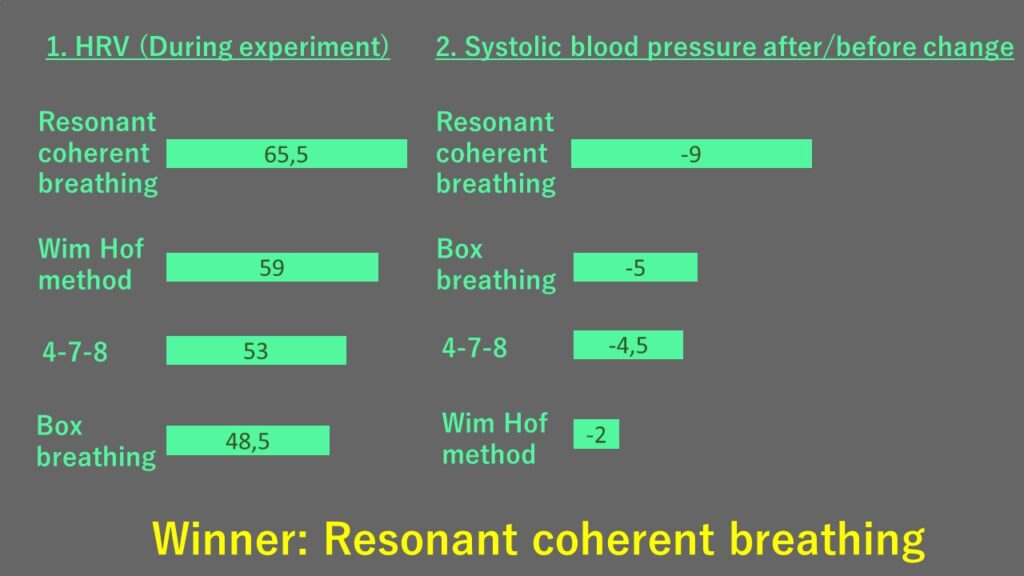Introduction
The way you breath affects your mental and physical well-being. I want to know best breathing techniques for better health. I’m going to experiment 4 different breathing techniques, each for 10 days. During this experiment I’m going to measure following parameters:

Each breathing session will be conducted in morning for 20 minutes. Based on this experiment I will create suitable breathing plan for me. If you are in hurry, you can skip to conclusion part in the end!
Table of Contents
Relaxing breath (also known as 4-7-8)
How to do it?
4 seconds in, 7 seconds pause and 8 seconds exhale. Tip of your tongue should be placed behind upper front teeth.
What is it used for?
Reduce anxiety & help to get sleep
What science says?
There isn’t many scientific studies on 4-7-8, I actually found only one. Study was titled “Effect of 4-7-8 breathing technique on anxiety and depression in moderate chronic obstructive pulmonar disease patients”. Study concluded that 4-7-8 breathing technique is effective in reducing dyspnea, anxiety and depression on that partical patient group. [1]
Useful links
1 Hour guided 4-7-8 breathing meditation
My results with 4-7-8 (10 sessions)
Before / After
Heart rate: +2 (55/57)
Systolic blood pressure: -4,5 (126 / 121,5)
Diastolic blood pressure: +1,5 (71 / 72,5)
During
HRV: 53
Lowest heart rate: 56,5
My opinion about 4-7-8
I wasn’t impressed with values I got with 4-7-8 breathing, only 4,5 decrease on systolic blood pressure. As for practising 4-7-8, it’s something that you need to focus to keep on right rhythm. That being said, 20 minutes of 4-7-8 can make you sleepy. I am not sworn by this technique, I think there are better ones out there.
Resonant coherent breathing
How to do it?
Its deep breath with same duration for inhale and exhale. Most popular duration is 5,5 seconds inhale and 5,5 exhale, no pauses between. I did it 6 seconds for each, making it 5 breaths per minute. That is way under normal breathing rate which is 12 – 20 for adult in rest [2].
What is it used for?
For relaxation and health benefits (lower blood pressure and increased HRV)
What science says?
I searched scientific literature to find out benefits of deep breath, anything from 4 – 10 breaths per minute. Resonant coherent breathing doesn’t have to be 5,5 seconds inhale and exhale, optimal range can vary depending on individual. I was happy find out lots of research on deep breath, here are key take ways:
5,5 breath per minute is optimal for improved HRV compared to other breathing rates [3].
Meta-analysis from 2017 concluded that controlled slow breathing has positive effects on blood pressure and HRV [4].
Deep breathing can improve mood and decrease stress [5].
Deep breathing is potential tool to improve cognitive performance and decrease harmful effects of stress [6].
Resonant breathing improved HRV, mood and blood pressure [7].
Useful links
Guided Resonant coherent breathing exercise
My result with resonant coherent breathing
Before / After
Heart rate: 0 (55/57)
Systolic blood pressure: -9 (123 / 114)
Diastolic blood pressure: +2,5 (71 / 72,50)
During
HRV: 65,5
Lowest heart rate: 55
My opinion about resonant coherent breathing
I really loved doing this, 6 seconds inhale and exhale brings state of relaxation and bliss. Comparing to 4-7-8, you didn’t really have to think about the rhythm, it came automatically. Results were consistent with my feelings: Systolic blood pressure dropped significantly with resonant coherent breathing and HRV during exercise were highest comparing to other techniques.
Wim Hof Method (also known as Tummo)
How to do it?
Wim Hof method is more complex than other breathing techniques, this requires little bit more explanation. Basic idea is four rounds of 30-40 breaths and between rounds retention phase (stop breathing). Wim Hof method differs vastly from other techniques in this experiment, breath per minute can be almost 30 breaths per minute. I did Wim hof method with following details:
Round 1: 40 breaths + breath hold for 2 minutes
Round 2: 40 breaths + breath hold for 2 minutes
Round 3: 40 breaths + breath hold for 2 minutes 30 seconds
Round 4: 40 breaths + breath hold for 3 minutes
I breath through nose and sit comfortably on the sofa.
What is it used for?
Increased energy and reduced stress levels. It can also improve your immune system.
What science says?
Scientific studies on Wim Hof method has been noticed by mainstream media. First study on 2014 revealed that with Wim Hof method it is possible to influence your immune system. Study investigated two groups, intervention group which trained Wim Hof method for 3 days and control group. Both groups underwent experimental endotoxemia (bacterial injection) which is known to cause sickness. Wim Hof trained group experienced fewer flu like symptoms, and symptoms disappeared faster. Study speculates that reason for this is probably increase in epinephrine and subsequent attenuation of the inflammatory response, caused by breathing techniques. [8]
Second highly cited study focuses on Wim Hof and his ability to withstand extreme cold. In this study Wim Hof was exposed to cold water, his body temperature should have dropped significantly but instead it remain flat. Based on fMRI and PET/CT imaging, results showed that Wim Hof can induce activation of periaqueductal gray area (PAG) in the brain, which is associated with pain tolerance and general well-being. Study was named “Brain over body” which is apt name for this phenomenon. [9]
Useful links
Guided Wim Hof method breathing with master himself
Good video recap of Wim Hof method immune system study
Good video recap of Wim Hof method brain over body study
My result with Wim Hof method
Before / After
Heart rate: -1 (54,5/53,5)
Systolic blood pressure: -2 (123 / 121)
Diastolic blood pressure: +5 (73 / 78)
During
HRV: 59
Lowest heart rate: 55
My opinion about Wim Hof method (WFM)
I participated two day WFM course in 2018. I still remember vividly strange tingly sensations that appeared with WFM breathing. Most memorable moment is however being in the freezing cold lake many minutes, much longer than I thought I could endure. Whole experience was amazing but I kinda forgot WFM as everyday life continued. Reading James Nestor’s book Breath got me back to Wim Hof breathing. James Nestor encouraged breathing through nose when doing WFM. This way of doing it felt better to me than mouth breathing which was taught in the workshop 2018.
WFM results didn’t stand out but its not fair to compare WFM to other breathing techniques in terms of lowering blood pressure immediately after exercise. WFM produces hormetic response and benefits can be seen later on. Still, HRV was second highest of all techniques, averaging 59.
I love the feeling after WFM exercise, it will definitely be part of my life from now on. WFM is very intense powerful exercise, I feel like its best to do in the morning when I want to have productive day. If I am overly stressed, I rather use resonant coherent breathing.
Box breathing
How to do it?
In box breathing you do 4 seconds of each step: inhale, pause, exhale, pause.
What is it used for?
It can be used on tense situation to stay focused (popular with Navy SEALSs), but also good for stress reduction and better sleep
What science says?
Similarly to 4-7-8, I had troubles to find scientific studies on this method. I didn’t find any where they exactly focused on box breathing.
Useful links
Box Breathing proponent Mark Divine explaining technique
My result with box breathing
Before / After
Heart rate: +3,5 (53/56,5)
Systolic blood pressure: -5 (123,5 / 118,5)
Diastolic blood pressure: +2,5 (72 / 74,5)
During
HRV: 48,5
Lowest heart rate: 53,5
My opinion about box breathing
I have same thoughts on box breathing than 4-7-8. Wont be my number one choice or even number two.
Conclusion
I wanted to test out different breathing techniques and their effect on HRV and blood pressure. One breathing technique stand out from the group:

With resonant coherent breathing my average HRV increased most (65,5) and systolic blood pressure dropped most (-9). From now on I will practice resonant coherent breathing with meditation sessions.
I was also happy to find out Wim Hof method again with this experiment. Of all techniques it gave me best feeling afterwards. I want to continue my WMF journey so I enrolled for advanced course.
Regarding the results, its important to mention that I was on holiday when conducting 4-7-8 and resonant coherent breathing. Work day morning is always different than holiday morning.
There’s so much to learn with breathing, I feel like I’m still beginning of the journey. This experiment was good learning experiment for me. I encourage like minded people to conduct their own experiments and find out the best techniques for them.


This Post Has 8 Comments
It used to be that every person have its own resonant breathing frequency somewhere 4-7 bpr.
Thanks for comment and I agree as we are all individuals.
Книга ” Эндогенное дыхание медицина третьего тысячелетия ” автор Владимир Фролов. Самая эффективная методика по дыханию.
https://latane.livejournal.com/49060.html
https://litresp.ru/chitat/ru/%D0%A4/frolov-vladimir/endogennoe-dihanie–medicina-tretjego-tisyacheletiya/48
Thanks for comment. I will check that book!
Great post, you have pointed out some great details , I likewise think this s a very fantastic website. Cele Skell Faunia
Thank you. This was great information!
What tool did you use to measure blood pressure and HRV?
Thank you Jimmy
For blood pressure standard omron monitor and for HRV Oura ring (moment feature)
I did the same experience and I came to the same conclusion. I do enjoy Wim breathing technique in the morning too. This gives me some good energy for the day and I also do it if I feel shitty, like a cold/flu symptoms coming on…it stops it right there. For coherent breathing I find that if you put your left hand on your heart center it will keep the HRV readings more constant. It will also lower your blood pressure. When doing box and 4-7-8 my HRV was all over the place. I did measure with Oura ring but find that Garmin HR Pro is superior and gets better readings. I use Elite HRV to track HRV scores,